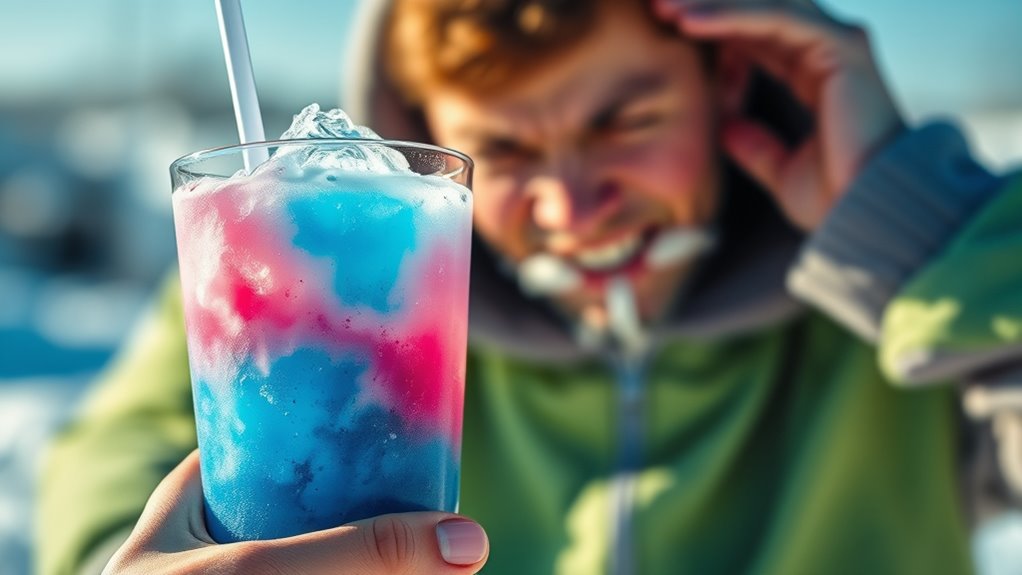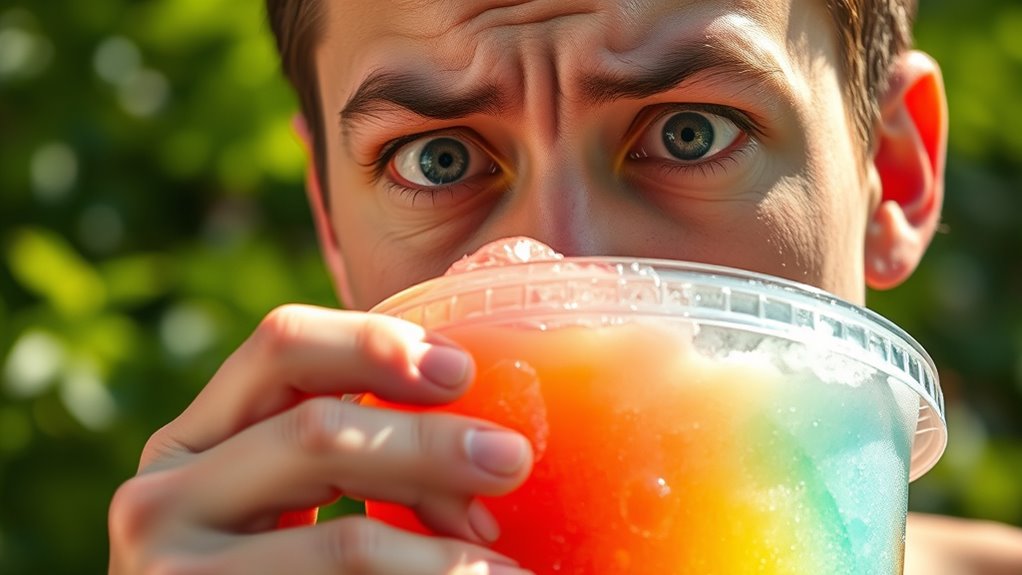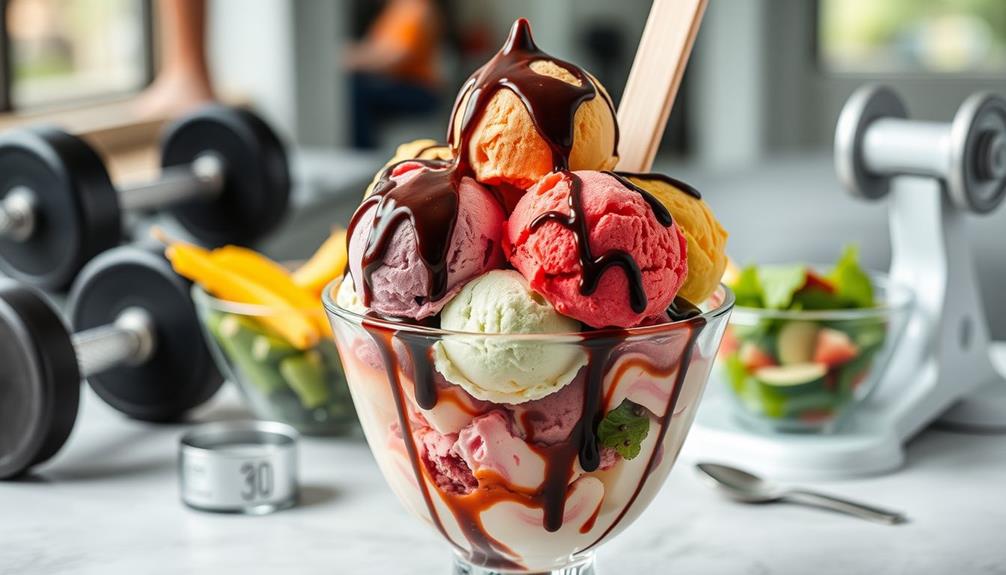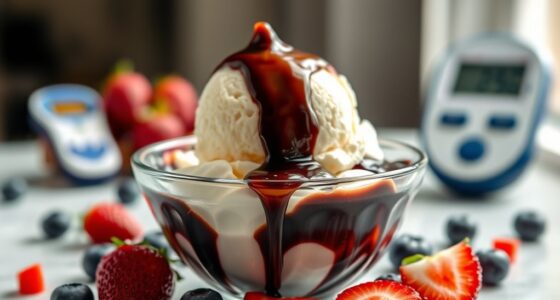Brain freeze, or sphenopalatine ganglioneuralgia, hits when you eat cold treats too fast and causes sharp pain in your forehead. It happens because the trigeminal nerve gets activated, resulting in sudden pain. To avoid this chilly agony, take smaller bites, eat slowly, and position cold foods at the front of your mouth. There’s more to discover about this unexpected discomfort and how to manage it effectively, so let’s explore further.
Key Takeaways
- Brain freeze, or sphenopalatine ganglioneuralgia, is a sharp headache triggered by consuming cold items too quickly, causing pain in the forehead.
- To prevent brain freeze, eat cold foods slowly and take smaller bites or sips to avoid sudden temperature changes.
- Avoid using straws, as they can lead to rapid intake of cold beverages, increasing the risk of brain freeze.
- Position cold foods toward the front of the mouth to allow them to warm slightly before reaching the roof of your mouth.
- If you experience brain freeze, press your tongue against the roof of your mouth or sip a room-temperature beverage for relief.
Definition and Causes of Brain Freeze

Brain freeze, or sphenopalatine ganglioneuralgia, hits you with a sharp pain in your forehead when you eat or drink something cold too quickly.
This intense but temporary headache typically lasts from a few seconds to two minutes. The culprit? Sudden, extreme cold on the roof of your mouth triggers the trigeminal and sphenopalatine ganglion nerves, causing pain through a phenomenon known as referred pain. Effective relaxation techniques can help reduce the discomfort when experiencing brain freeze. Maintaining adequate hydration is also essential for overall health and may help mitigate the sensation. Additionally, consuming flavorful appetizers at a moderate temperature can help prevent triggering this painful response. Excessive consumption of cold treats like ice cream, which contains high sugar and fat content, can also lead to health issues, including weight gain.
Your blood vessels constrict and then dilate rapidly in response to the cold, contributing to the sensation. Not everyone experiences brain freeze despite having a trigeminal nerve, as some individuals may have more sensitive nerves.
Anyone can experience brain freeze, but children and those prone to migraines might face it more often.
Fortunately, it’s not a serious condition and doesn’t indicate any underlying health problems.
Physiological Response to Brain Freeze

When you indulge in something cold too quickly, your body responds with a complex physiological reaction that can lead to that sharp forehead pain known as brain freeze.
The trigeminal nerve, responsible for sensation in your face, detects the cold and transmits pain signals. This activation can cause referred pain, making you feel discomfort in your forehead instead of your mouth. Interestingly, essential oils, particularly aromatherapy blends, can be utilized to alleviate headache symptoms and promote relaxation. Additionally, maintaining proper nutrition is essential for overall cognitive function and may influence how you experience pain.
As your blood vessels constrict and then rapidly dilate, your brain interprets these changes as pain, resulting in that intense sensation. Interestingly, this reaction is actually a protective mechanism that signals your body to slow down. In fact, understanding the emotional coldness that can develop in long-term relationships may help provide insights into how our bodies respond to stress and discomfort. Additionally, just as essential oils can influence emotional well-being, the way your body reacts to cold stimuli highlights the complex interplay between physical sensations and psychological responses.
Curiously, about 40% of people are susceptible to this phenomenon, with migraine sufferers being more prone.
This brief but intense pain typically lasts only seconds, but understanding it can shed light on other headache mechanisms.
Prevention Strategies for Brain Freeze

To prevent brain freeze, understanding its triggers is essential. This phenomenon occurs when cold substances contact the roof of your mouth. To avoid it, eat slowly and take smaller bites or sips to reduce sudden temperature changes. Skip the straw, as it can cause rapid intake of cold drinks. Position cold foods toward the front of your mouth to warm them slightly before they hit your palate. Brain freeze can also occur from breathing cold air or jumping into cold water, so be mindful of these situations as well. When outdoors in cold weather, wear a mask or scarf for protection. Additionally, be aware that consuming cold beverages quickly can have a similar effect as high humidity in disrupting your body’s temperature regulation. Implementing strategies such as calibration of your eating habits can significantly help in minimizing the risk of brain freeze. Allow cold items to sit for a minute before consuming, or alternate between cold and warm foods. Engaging in visualization techniques can also help you maintain awareness of your body’s responses to cold stimuli. Incorporating juice cleanses into your diet can also support overall wellness, which may help your body adapt better to temperature changes.
Comparison With Other Headaches

Understanding how to prevent brain freeze also sheds light on how it compares to other types of headaches.
Brain freeze is a quick response to cold stimuli, causing intense but short-lived pain. Unlike migraines, which can last hours and feature symptoms like nausea, brain freeze typically lasts only seconds to a minute. Both involve the trigeminal nerve and blood vessel changes, but brain freeze generates referred pain primarily in the forehead. Other headaches often have varying causes and longer durations. While the pain of brain freeze is intense, it doesn’t carry the same risk or complications as migraines or tension headaches. Recognizing these differences enhances your understanding of headache types and their underlying mechanisms. The pain from brain freeze is linked to blood vessel changes that occur rapidly in response to cold. Additionally, caffeine consumption can influence the severity and frequency of certain headache types. Understanding the IRS regulations governing investments can also help in managing financial stress that may trigger headaches. Moreover, a significant financial burden can lead to increased stress levels, which may contribute to RMD penalties associated with retirement planning. Investing in a Bitcoin IRA can offer a unique way to secure your financial future while potentially reducing stress related to retirement savings.
Demographics and Susceptibility

Although brain freeze can affect anyone, certain demographics show higher susceptibility to this sudden headache.
Children experience brain freeze more often than adults, likely because their smaller anatomical structures cool more quickly. As you age, this sensitivity tends to decrease, but younger individuals, especially students, often report more incidents. Interestingly, brain freeze is more frequent in children than adults, highlighting the importance of understanding this phenomenon in younger populations. Additionally, early socialization opportunities can help children develop better coping mechanisms for various physical sensations, including discomfort from cold stimuli. Furthermore, engaging in activities that boost emotional resilience may assist children in managing discomfort more effectively. Effective communication can also help children articulate their experiences with discomfort, further aiding their coping strategies. Incorporating nutrient-dense foods like chia seeds into their diets may also support overall wellness and resilience.
Curiously, research suggests women, particularly those who suffer from migraines, may be more prone to brain freeze than men. If you have a family history of migraines or cold-stimulus headaches, you might also be at a higher risk.
Neurological sensitivity plays a role too; some people’s trigeminal nerves react more strongly to cold stimuli, increasing their chance of experiencing brain freeze.
Management and Treatment of Brain Freeze

Experiencing brain freeze can be quite uncomfortable, but knowing how to manage and treat it can make all the difference.
If you find yourself in pain, try pressing your tongue against the roof of your mouth to warm it up. Sipping a room-temperature beverage can also help soothe the discomfort. Breathing in warm air by cupping your hands over your mouth and nose may provide relief as well. Additionally, understanding that brain freeze is caused by rapid changes in blood vessel size can help you prevent it in the future. Regular self-exams for potential health issues can also aid in early detection of other conditions. It’s important to be aware that environmental interactions can influence how your body responds to sudden temperature changes.
Gently massaging the back of your neck can distract you from the pain. Generally, you won’t need over-the-counter pain relievers since brain freeze resolves quickly.
Fun Facts About Brain Freeze

Brain freeze might feel like a sudden jolt to your head, but it’s a captivating phenomenon rooted in science. Officially known as sphenopalatine ganglioneuralgia, it happens when you consume something cold too quickly. Kids are more prone to it, likely due to their enthusiasm for frozen treats. Notably, about one-third of people experience brain freeze, often linked to migraine sufferers.
The trigeminal nerve plays an essential role in this pain, signaling discomfort as blood vessels rapidly constrict and dilate. The brain interprets you might feel the pain in your forehead due to referred sensations.
Surprisingly, brain freeze isn’t harmful and resolves on its own within seconds to minutes, making it a curious yet benign experience during hot weather.
Frequently Asked Questions
Can Brain Freeze Cause Any Long-Term Damage?
No, brain freeze can’t cause any long-term damage.
When you experience that sharp pain, it’s just a temporary reaction to cold stimuli affecting your trigeminal nerve. It lasts only seconds to minutes and resolves on its own.
You won’t face any lasting health issues or complications from it.
To avoid brain freeze in the future, just take smaller bites or sips of cold foods and drinks, and you’ll be fine.
Is Brain Freeze More Common in Certain Climates?
You might think brain freeze is more common in the Arctic, but it’s actually a universal experience!
While climate doesn’t directly influence its occurrence, warmer weather often leads you to devour cold treats faster.
So, if you’re in a hot place, you’re likely to face that sudden headache after a quick sip of icy drink.
Just remember, taking your time and warming up your mouth can save you from that frosty agony!
Do Certain Foods Cause More Brain Freeze Than Others?
Yes, certain foods do cause more brain freeze than others.
Ice cream, snow cones, and popsicles are notorious for triggering this sensation due to their extreme cold temperatures and solid forms. Eating these foods too quickly increases your risk.
Densely packed items tend to make the experience more intense compared to cold beverages.
Can Children Experience Brain Freeze Differently Than Adults?
Yes, children can experience brain freeze differently than adults. Their smaller anatomical structures and faster eating habits make them more susceptible to the intense pain.
You might notice that kids tend to consume cold treats quickly, increasing their likelihood of discomfort. Additionally, they may not have learned to recognize or adapt to the sensations, making them more prone to sudden headaches compared to adults, who often adjust their eating behaviors over time.
Are There Any Cultural Beliefs About Brain Freeze?
Just like a sudden chill on a summer day, brain freeze catches you off guard, but it lacks deep cultural significance.
While many people experience it, there’s not much folklore or belief surrounding it. Most cultures recognize it as a common, albeit amusing, phenomenon.
You might hear jokes about it, but ultimately, it’s just a temporary nuisance that most people laugh off while enjoying their favorite icy treats.
Conclusion
Next time you indulge in that frosty treat, remember that brain freeze, or your head’s little rebellion, is just a fleeting moment of discomfort. By taking it slow and letting your mouth warm up the cold, you can sidestep this icy inconvenience. Embrace the joy of your favorite flavors without the chilly aftermath. After all, a little patience can turn a brain freeze into a delightful experience, keeping the good times rolling without a hitch!










